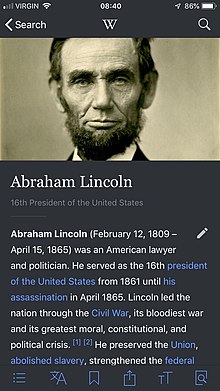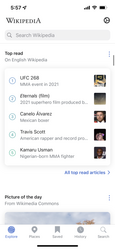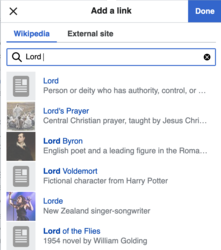ویکیپدیا:قیسا آچیقلاما
بۇ صفحه بیر بیلگی صفحهسی دیر. مربوط اولان دییشیک ایجماعسینین قورولموش تجروبهسینی، بعضی جهت و یا جهتلرده، ویکیپدیا نورماللاری و روسوملاری ایله آچیقلاییر. بو ویکیپدیانین سیاستیندن و قایدالاریندان بیری دئییل، چونکی بونون اوستونده ایجماع یوخدور. |
| بو صفحه بیر باخیشدا: هر بیر ویکیپدیا مقالهسی ۴۰ کاراکتردن چوخ اولمایان قیسا آچیقلاما شکلینده اونون ایحاطه دایرهسینین قیسا توضیحینی داخیل ائتمهلیدیر. بو توضیحلر ویکیپدیا موبایل و بعضی دسکتاپ آختاریشلاریندا گورونور و ایستیفادهچیلره ایستدیکلری مقالهنین موعین ائتمهیه کؤمک ائدیر. |

ویکیپدیا مقالهسینین و یا باشقا آدفضاسی صفحهسینین قیسا آچیقلاما، صفحهنین اَحاطه دایرهسینین قیسا ایضاحیدیر. بو توضیحلر ویکیپدیا موبایل و بعضی دسکتاپ آختاریشلاریندا گؤرونور و ایستیفادهچیلره ایستهدیکلری مقالهنی مۆعین ائتمهیه کؤمک ائدیر. The Wikipedia mobile app also displays them below each article title. Although they are not yet displayed in most desktop searches, the Visual Editor uses them to annotate the list of possible matches when making a wikilink. Short descriptions are likely to become more widely used, both within Wikipedia and by third parties, as the proportion of articles lacking one falls.
Short descriptions do not appear by default in desktop view, but desktop users who wish to see and edit them conveniently can do so with the Shortdesc helper gadget.
هدفلر
[دَییشدیر]Short descriptions serve several purposes: a very brief indication of the field covered by the article; a short descriptive annotation; and a disambiguation in searches, especially to distinguish the subject from similarly titled subjects in different fields.
گرککی قیسا آچیقلاماسی اوْلان صفحهلر
[دَییشدیر]بوتون اَساسفضا مقالهلرین قیسا توضیحی اوْلمالیدیر. Redirects and most non-mainspace pages do not normally need a description, although one may be added in the rare cases it would be useful.
The short description may appear directly in the wikicode for the page, via the {{Short description}} template, or may be transcluded automatically from a multi-page template such an an infobox. Disambiguation pages and list articles both make use of transcluded descriptions, and those do not normally need to be edited manually.
Content
[دَییشدیر]
The short description is part of the article content, and is subject to the normal rules on content, including Wikipedia:Neutral point of view and Wikipedia:Biographies of living persons. The normal editing rules such as Wikipedia:Consensus and Bold–Revert–Discuss also apply.
Editors adding or amending short descriptions should bear in mind that they are they are not intended to define the subject matter of the article. Rather, they provide a very brief indication of the field that is covered, a short descriptive annotation, and a disambiguation in searches (especially to distinguish the subject from similarly titled subjects in different fields).
Each page should ideally have its own purpose-written short description. While the Shortdesc helper allows the viewing and import of text from Wikidata, that should be done sparingly, as Wikidata descriptions are not subject to Wikipedia's policies, and have a different purpose. They may sometimes be appropriate, but often are too long and/or technical to be used here. They also may not have received the same level of error checking. It is the responsibility of the editor to ensure that the short description is appropriate, accurate, and compliant with Wikipedia content policies. This is especially important for biographies of living people and for medical articles.
Content
[دَییشدیر]When visible on desktop or mobile the short description immediately follows the article title, and should be comprehensible in that location. Short descriptions should so far as possible:
- focus on the purposes stated above, without attempting to define the subject or to summarise the lead
- use universally accepted facts that will not be subject to rapid change, avoiding anything that could be construed as controversial or judgemental
- avoid jargon, and use simple, readily comprehensible terms that do not require pre-existing detailed knowledge of the subject
- avoid duplicating information that is already in the title (but don't worry too much if you need to repeat a word or two for context)
- start with the most important information (since some mobile applications may truncate longer descriptions).
Formatting
[دَییشدیر]As a short descriptive annotation, each short description should:
- be brief: aim for no more than about 40 characters (but this can be exceeded when necessary)
- be written in plain text, without HTML tags or Wiki markup
- start with a capital letter, and avoid a final full stop
- avoid initial articles (A, An, The).
"None" as a short description
[دَییشدیر]If an article title is sufficiently detailed that an additional short description would not be helpful, e.g. Alpine skiing at the 1960 Winter Olympics – Men's downhill, a description of "none" should be used to remove the article from the missing-description tracking categories, thus: {{Short description|none}}. Occasionally, a default value of "none" may already be transcluded, for example for Wikipedia list articles; that should not normally need to be edited, but can be overridden for a specific page by adding {{Short description|Overriding description}}.
Inclusion of dates
[دَییشدیر]The inclusion of a date or date range is encouraged where it would improve the short description as a disambiguation, or enhance it as a descriptive annotation. Generally that is the case at least for biographies, articles on specific publications, and dated historical events. Editor discretion is always needed, and in some cases there will be more important information than dating to be included within the available 40 or so characters, but if space is available such dates are encouraged.
Care should be taken where WP:BLP applies, and birth dates for living people should not be copied from the page unless sourced.
The following date formats are recommended for consistency but can be varied if there is consensus that in some particular case an alternative date format would be better. In the table below, the examples illustrate the recommended date format only; they are not intended to recommend any particular descriptive wording.
In biographies, care should be taken to distinguish between dates which define a lifespan and those which define a period in office: lifespans should normally be specified by "(birthyear–deathyear)", and periods in office by "from startyear to endyear". For historical biographies, specific dates such as "1750–1810", where known, are preferred to "18th-century", as it is not clear whether that means "born and died during the century", "in office during the century" or "mostly active during the century". Other dated events or ranges can use any convenient dating format, as long as the meaning is clear.
| Type | Criterion | Recommended date format | Examples |
|---|---|---|---|
| Biography | Lifetime most important | [Person description] (birthyear–deathyear) | English composer (1668–1735) |
| BLP or year of death unknown: [Person desc] (born birthyear) | English composer (born 1668) | ||
| Year of birth unknown: [Person desc] (died deathyear) | English composer (died 1735) | ||
| Period in office most important | [Office description] from startyear to endyear |
| |
| Publication | Publication in a specific year | Publicationyear [Description] |
|
| Historical | Event in a specific year | Eventyear [Description] | 1861 American Civil War battle |
| Period or range | [Description] from startyear to endyear | Epidemic of bubonic plague from 1665 to 1666 | |
| [Description] (startyear–endyear) | Epidemic of bubonic plague (1665–1666) | ||
| [Description], startyear–endyear | Epidemic of bubonic plague, 1665–1666 |
Where a date is not known exactly, "c. " may be used for "circa". Other examples are given at WP:APPROXDATE, although "fl. " for "floruit" should be avoided as it is not universally understood. Centuries should not be abbreviated "c. " due to the potential for confusion with "circa".
How to edit
[دَییشدیر]Single page
[دَییشدیر]The most convenient way to create and edit short descriptions on the desktop is to use the Shortdesc helper gadget. Alternatively, you can manually amend the {{short description}} template. Short descriptions cannot yet be edited with the Visual Editor.
If you're manually editing on desktop and don't have the gadget loaded please don't add a brand new {{short description}} solely on the basis that the template is missing from the wikicode. Transcluded descriptions are not shown in the code for the page, and you may well be unhelpfully overwriting a transcluded description that has consensus across a wide range of pages. For more information, see #Why can't I see any short description?
If editing manually, do not start the template with a space, thus: {{ Short description... as this may break other templates which search for the {{Short description... text. Always use the {{short description}} template directly – do not use any alias.
Placement
[دَییشدیر]Per , the template should always be the very first element on the page. This means that it goes above any hatnotes, deletion/protection tags (CSD, PROD, AFD, PP notices), maintenance or dispute tags, title styles, and English variety/date styles. There is one exception to this, namely redirects. If (unusually) you need to add a short description to a redirect, you should add {{short description}} below #REDIRECT. For more information, see #Short descriptions on redirect pages. Placement is handled automatically if you are using Shortdesc helper.
By transclusion into multiple pages
[دَییشدیر]Where a single short description is suitable for multiple articles that all use the same template (such as a specific infobox), the description can be transcluded from the infobox rather than being added one by one to each article. In that case {{short description}} does not appear in the wikicode for the page.
Such transclusions are normally done after local consensus by template editors. Please add a |noreplace parameter so that the result can be overridden by a later manually inserted instance.
Why can't I see any short description?
[دَییشدیر]By default, short descriptions are not displayed in desktop view. To make them visible on the page and to enable easy editing, install the Shortdesc helper gadget. If you don't want to install the gadget, the easiest way to check for the existence of a short description is to view the page on a mobile platform, where it should appear immediately below the title.
You can always see whether the page has a manual short description by opening it for source editing (not visual editing); you should find {{short description}} right at the top. Unfortunately, the absence of {{short description}} in the wikicode does not necessarly mean that a short description is missing, as it may be transcluded from some template such as an infobox. That can't be determined from the page code (at least without following through to the template code pages), hence the recommendation to install Shortdesc helper.
Please don't add a new short description solely on the basis that {{short description}} is missing from the wikicode, as you may well be unhelpfully overwriting a transcluded description that has consenus across a wide range of pages.
Short descriptions on redirect pages
[دَییشدیر]Most redirects do not require a short description, but there are a few circumstances in which it may be useful to add one:
- soft redirects for which an annotation would be useful
- where the redirect page is the target of an {{Annotated link}}
- as an indicator that the topic described may be a valid article topic
{{Short description}} conflicts with the magic word #REDIRECT if placed in the standard position at the top of the page. For such pages only, the template should be placed not at the top but immediately underneath #REDIRECT.
The short description of a Redirect to section should refer to the section content and should not generally be the same as that of the article itself.
Annotated links
[دَییشدیر]The {{Annotated link}} template can be used to automatically annotate a wikilink with a corresponding short description for the page. This may be useful where links to multiple pages are presented in the form of a list, for example in "See also" sections. {{Annotated link}} does not follow redirects, and if the link has to point to a redirect it may be appropriate to add a short description to the redirect page itself.
History
[دَییشدیر]Short descriptions were initially implemented by WMF developers primarily as a search disambiguator, using item descriptions from Wikidata. After concerns were raised about accuracy, suitability, and the potential for hard-to-detect vandalism on Wikidata, the developers created a SHORTDESC magic word, giving editors the ability to override the Wikidata text directly on Wikipedia, as was discussed here:
- Incidents § Hard to detect mobile vandalism
- Village pump (technical) § Discussion at ANI about Wikidata use in mobile view
- Rfc: Remove description taken from Wikidata from mobile view of en-WP
- Blockers to having short description on mobile
- RfC: Populating article descriptions magic word
- Wikipedia talk:Wikidata/2018 State of affairs § Short descriptions
- Template talk:Short description/Archive 1 § Some history and explanation of this template for those without the time or inclination to read the full discussion
- Phabricator ticket T184000
- Phabricator ticket T193857
The magic word approach was later superseded by the current Wikipedia template {{Short description}}. In a first iteration, mobile devices displayed the Wikipedia-specific short description where that existed, but continued to display the Wikidata text where it did not. In 2020, use of Wikidata text to characterise Wikipedia content was discontinued. Mobile devices now display the Wikipedia description if it exists, and display no short description if it does not.


